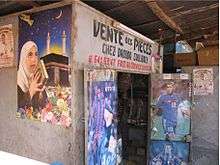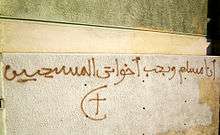Islamic graffiti
Islamic graffiti is a genre of graffiti created by Islamic people or by people inspired by the Islamic religion. Containing Islamic themes, this type of art finds expression in a variety of forms. The most common languages used are English and Arabic. Like all other forms of art, graffiti can serve as a medium for instigating political or social change, or as a form of self-expression.
Socio-Political
Sticker Art
Sticker art refers to the practice of posting images or phrases to convey a message.

- A collaborative project called "INSIDE OUT: Artocracy in Tunisia" uses sticker art to promote the spirit of democracy in post-revolutionary Tunisia. Prior to the revolution, only presidential photography could be found in the public space. A group of six photographers, along with a French graffiti artist called JR, replaced these pictures with black and white photographs of anonymous Tunisian people. Their goal is to inspire the people of Tunisia to see themselves in a new light. One of the photographers states: "If people want to tear them down, or write something on them, that's part of the project, that's okay."[1]
Subvertising
Subvertising refers to the practice of making spoofs or parodies of political advertisements.
- Princess Hijab, an anonymous street artist from Paris, paints Muslim veils on advertisements in the subway. She refers to this as "hijabisation." Since the enforcement of the "burqa ban," in which women are prohibited from wearing the burqa in public places, her art has sparked feminist and fundamentalist questions. It is not known if Princess Hijab is a Muslim or even a woman. "The real identity behind Princess Hijab is of no importance," she has been quoted. Inspired by Naomi Klein's No Logo, she drew her first veil in 2006 on the French rapper Diam's. Ironically, this woman converted to Islam and now wears the veil in reality. Graffiti on the subways in Paris is considered vandalism. Consequently, Princess Hijab has become highly selective and only paints four to five advertisements a year. She chooses to combine veils with advertisements because they are both "dogmas that can be questioned."[2]
Spray Paint

- Graffiti as a form of communication in Palestine began in 1987 during the first Intifada. This was a period in which there were no Palestinian TV or Radio stations in the Gaza Strip. Murals commemorated martyrs as well as called protestors to action. Israeli military would force Palestinians to wash off graffiti from their homes. The Dome of the Rock was common among murals in Palestine. In 2006, Hamas took over the graffiti scene. Hamas would encourage people to perform the first of the day’s five prayers through street art.[3] Currently, The West Bank wall is covered in graffiti. Numerous messages can be found including marriage proposals, notes to friends, and jokes. Also common are messages of peace. One reads: "Mirror, mirror on the wall. When will this senseless object fall?" "Trying to imagine a clear view between Palestine and Israel," is another. Messages such as these splatter across the wall, and some graffiti artists will paint your message for a fee.[4]
Notable graffiti artists
Middle East
- see also graffiti in Tehran
- From Lebanon, Yazan Halwani has developed his form of graffiti based on Arabic calligraphy, figures and culture. His style mixes portraiture and Arabic calligraphy on large walls in Beirut. Halwani thinks that graffiti in the Arab world and Beirut should not evolve into a form of vandalism and therefore he says that his murals try to adapt to their environment and not against it. [5]
- From Tehran, graffiti artist A1one (a.k.a. Tanha) has been credited with starting the modern street art movement in Tehran and Middle East [6]
Nowadays he is an International artist, known for His innovative Arabic & Persian Calligraphic Street Art Painted in Various Countries. A1one started his career as an artist in the late 1990s with indoor painting.[7]

In 2003, he moved outdoors by spraying a 30x40cm stencil on university walls to express to the "uncommon pressure" at the university which was "endured in silence." However, the motivations behind his art are not protest. He states that his art is simply personal expression: "A drawing on the street is similar to a letter: It proves that there is a writer."[8]
In the Arab World, three major areas of interest can be identified: Lebanon, the Palestinian Territories and the Arab states that were involved in the Arab Spring. In these areas, graffiti has been perceived, both by the public and the media, as a barometer of the society. Lebanon’s religious and ethnic diversity and its position at the crossroad of the Mediterranean basin and the Arab World have contributed to the appearance and development of an active youth culture and graffiti is part of it. Secondly, the Palestinian Territories are a space where graffiti is one of the most powerful forms of protest against what its inhabitants perceive as a contemporary form of colonization. Last but not least, the social importance of graffiti and its militant functions have recently been reflected by the international media, within the coverage of the uprisings in Tunisia, Egypt, Libya and Syria. The media coverage of the Arab Spring has drawn attention to a type of both artistic and political expression typical for the young people in the MENA region.[9]
Europe
- After growing up in Paris during the late 80s and early 90s, graffiti artist eL Seed found himself inspired by hip-hop culture. With parents from Temoula, Southern Tunisia, he explored his North African origins by learning calligraphy. Before becoming an artist, he pursued degrees in Marketing and Business. After befriending a graffiti artist known as Hest1, he began to combine his love of graffiti and calligraphy. Today, he creates both personal exhibitions as well as murals for commission.[10]
- Also combining calligraphy with graffiti, Niels Meulman (also known as SHOE) coined the phrase “calligraffiti.” Born in Amsterdam, SHOE has worked for ad agencies such as BBDO and the television channel MTV. The metropolitan museum of art has called calligraffiti “a new explosive art form.”[11]
References
- ↑ Ryan, Yasmine (26 March 2011). "Art challenges Tunisian revolutionaries". Al Jazeera (in English and Arabic). Al Jazeera. Retrieved 9 June 2012.
- ↑ Chrisafis, Angelique (10 November 2010). "Cornered – Princess Hijab, Paris's elusive graffiti artist". The Guardian. Guardian News and Media. Retrieved 9 June 2012.
- ↑ Gröndahl, Mia. Gaza Graffiti: Messages of Love and Politics. Cairo: American University in Cairo, 2009. Print.
- ↑ Gray, Melissa (16 April 2009). "Palestinian graffiti spreads message of peace". CNN. CNN. Retrieved 9 June 2012.
- ↑ Alabaster, Olivia. "I like to write Beirut as it’s the city that gave us everything", The Daily Star, Beirut, 09 February 2013. Retrieved on 13 September 2014.
- ↑ Vandalog (3 May 2011). "A1one in Tehran IRAN". Vandalog. Retrieved 8 October 2012.
- ↑ "Graffitti in Tehran: Instigating Political Change". the bohemian. Social Active. 16 February 2011. Retrieved 9 June 2012.
- ↑ Uleshka (19 January 2007). "A1one: 1st generation Graffiti in Iran". PingMag. Retrieved 9 June 2012.
- ↑ Nicoarea, Georgiana. "Cultural Interactions in the Graffiti Subculture of the Arab World". Romano-Arabica Journal. Retrieved 2014-05-20.
- ↑ Alwazir, Atiaf Z. (6 June 2012). "Garbage Collectors and the Struggle For Workers' Rights in Yemen". Aslan Media. Aslan Media. Retrieved 9 June 2012.
- ↑ alice (4 November 2010). "Calligraffiti: An Explosive New Art Form (17 pics)". My Modern Met. My Modern Met. Retrieved 9 June 2012.